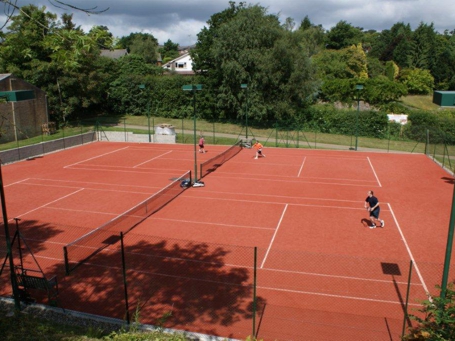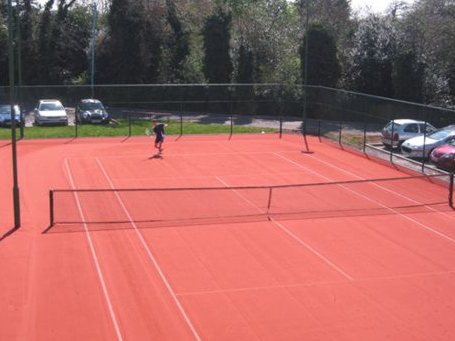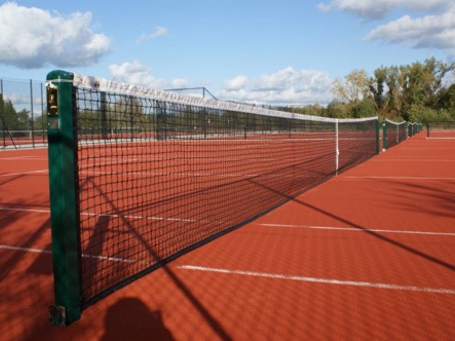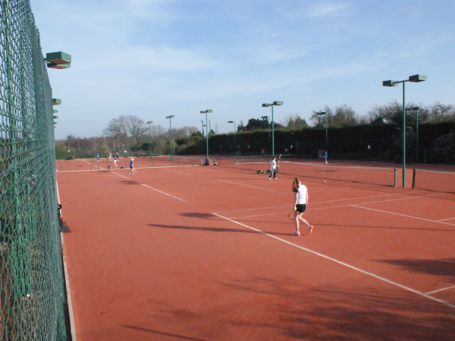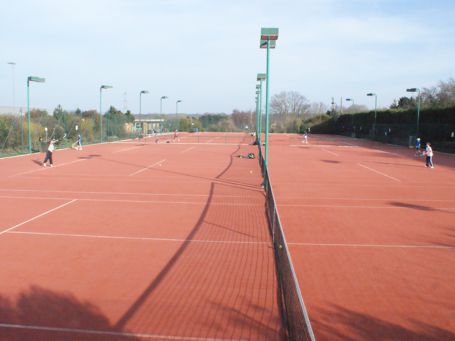Call now: +44 (0)1233 740574 or
e-mail: enquire@trevormay.co.uk
Reference Installations
- Stoke Park Country ClubFour courts
- Cross-in-Hand LTCTwo courts
- Dorking LTCThree courts
- Preston LTCFour courts
- Wimbledon ClubSeven courts
- Parklangley ClubSeven courts
- Magdalen Park LTCFour courts
- Westside LTCThree courts
- Coombe Wood LTCTwo courts
- Canterbury TCSix courts
- Sutton ChurchesFour courts
- Cumberland ClubThree courts
- Pavilion ClubThree courts
- Hurlingham ClubThree courts
- Lensbury ClubFour courts
- Wigmore LTCFour courts
- Wentworth ClubThree courts
- Sevenoaks LTCFour courts
- Blackheath LTCThree courts
- Old College LTCTwo courts
- Roehampton ClubSix courts
- Angmering LTCTwo courts
- Sundridge Park LTCFour courts
- Eton CollegeTen courts
- St Georges CollegeThree Courts
- Bromley LTCTwo courts
Construction
Advantage RedCourt® - artificial clay tennis courts.
The loose laid stability mat is normally installed over a porous macadam base in the UK. The mat is infilled with a red ceramic like fill that is installed to cover the mat. The top of the stability mat should be below the level of the perimeter edging to prevent wind lifting the edges of the mat and contain the infill at the perimeter.
Performance
Tennis: Medium slow surface pace - uniform low bounce - allows some top spin and slice-positive “push off” with controlled slide, some resilience. ITF classified court pace rating: Category 2.
A surface that will be available for use throughout most of the year. Care is required in freezing conditions when the surface may be too slippery to use.
Maintenance
Regular collection of debris and grooming after play with drag nets will maintain the neat appearance of the playing surface. Excess infill is swept off the play lines, as on a traditional clay court. The main requirement is weekly drag brushing to keep the infill mobile and evenly distributed. If neglected the surface will become less even, compacted and slower draining, with greater risk of moss growth.
In addition to weekly sweeping, it is advisable to have the court professionally maintained on an annual basis. The specialist’s equipment will provide a deeper sweeping operation and if necessary replace some of the infill on the top of the stability mat. It will also be necessary to apply moss killer on surfaces that are susceptible or have evidence of moss growth.
Advantage RedCourt Artificial Clay Tennis courts.
 Advantage RedCourt® is the name of the all year play, artificial clay tennis playing surface that we are pleased to offer to our clients. It is manufactured by EDEL Grass and uses a ceramic treated infill that totally fills the stability mat. The play lines are made using a special white yarn that gives higher durability and improved visibility.
Advantage RedCourt® is the name of the all year play, artificial clay tennis playing surface that we are pleased to offer to our clients. It is manufactured by EDEL Grass and uses a ceramic treated infill that totally fills the stability mat. The play lines are made using a special white yarn that gives higher durability and improved visibility.
This surface provides a highly practical alternative to traditional clay tennis courts, but with a similar appearance and play characteristics, available for year round play. Unlike traditional clay, there is no costly reconstruction each spring and no need for expensive irrigation. Artificial clay tennis courts combine low maintenance with high availability.
As the loose laid stability mat is normally installed over a porous macadam base in the UK, existing porous macadam courts can easily be upgraded to Advantage RedCourt®. A porosity and levels check will be undertaken prior to installing the stability mat and we will advise whether a macadam regulating layer is recommended.
The mat is in-filled with a red ceramic infill that is installed to cover the mat. The top of the stability mat should be at least 50mm below the level of the perimeter edging to prevent wind lifting the edges of the mat and contain the unbound fill at the perimeter.
The first installation in the UK was completed at Parklangley Club, Beckenham, Kent in April 2006.
Well over 60 courts have been completed since. You can see these reference installation at the top of the column on the right.
Reference Installations
- Stoke Park Country ClubFour courts
- Cross-in-Hand LTCTwo courts
- Dorking LTCThree courts
- Preston LTCFour courts
- Wimbledon ClubSeven courts
- Parklangley ClubSeven courts
- Magdalen Park LTCFour courts
- Westside LTCThree courts
- Coombe Wood LTCTwo courts
- Canterbury TCSix courts
- Sutton ChurchesFour courts
- Cumberland ClubThree courts
- Pavilion ClubThree courts
- Hurlingham ClubThree courts
- Lensbury ClubFour courts
- Wigmore LTCFour courts
- Wentworth ClubThree courts
- Sevenoaks LTCFour courts
- Blackheath LTCThree courts
- Old College LTCTwo courts
- Roehampton ClubSix courts
- Angmering LTCTwo courts
- Sundridge Park LTCFour courts
- Eton CollegeTen courts
- St Georges CollegeThree Courts
- Bromley LTCTwo courts
Construction
Advantage RedCourt® - artificial clay tennis courts.
The loose laid stability mat is normally installed over a porous macadam base in the UK. The mat is infilled with a red ceramic like fill that is installed to cover the mat. The top of the stability mat should be below the level of the perimeter edging to prevent wind lifting the edges of the mat and contain the infill at the perimeter.
Performance
Tennis: Medium slow surface pace - uniform low bounce - allows some top spin and slice-positive “push off” with controlled slide, some resilience. ITF classified court pace rating: Category 2.
A surface that will be available for use throughout most of the year. Care is required in freezing conditions when the surface may be too slippery to use.
Maintenance
Regular collection of debris and grooming after play with drag nets will maintain the neat appearance of the playing surface. Excess infill is swept off the play lines, as on a traditional clay court. The main requirement is weekly drag brushing to keep the infill mobile and evenly distributed. If neglected the surface will become less even, compacted and slower draining, with greater risk of moss growth.
In addition to weekly sweeping, it is advisable to have the court professionally maintained on an annual basis. The specialist’s equipment will provide a deeper sweeping operation and if necessary replace some of the infill on the top of the stability mat. It will also be necessary to apply moss killer on surfaces that are susceptible or have evidence of moss growth.

